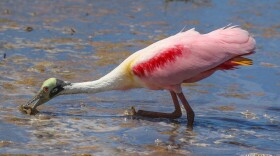-
A limpkin visited Scituate and a common cuckoo visited New Hampshire in recent days.
-
Turkeys have a role to play in the emergence of that pest du jour, the Lone Star Tick, and the weird red-meat allergy they transmit, alpha-gal syndrome. You could say that when it comes to alpha-gal, turkeys giveth, and turkeys taketh away.
-
Townsend’s Solitaire is the only US representative of a group of mostly mountain dwelling thrushes of Central and South America, plus Hawaii somehow, and are some of my favorite birds. They are related to our bluebirds and robins but are better singers than both.
-
A common theme on the bird report is the omnidirectional origins of the interesting birds we see, especially in fall – in any given week we may see lost birds from Europe, Western Canada, the Caribbean, and the desert southwest. This week is a good example, with species hailing from all of these destinations making landfall on the Cape.
-
Brown Boobies look a lot like young gannets, which are various shades of brown, but unlike gannets, they will sit on rocks close to shore for long periods – gannets essentially never come ashore around here unless they’re sick.
-
With All Hallows Eve rapidly approaching, I thought it was high time to explore the spookier side of birds.
-
Roseate Spoonbills are a Florida bird to us easterners, but most of their range is in South America.
-
The bar-tailed Godwit is a tall, long-billed sandpiper that has in recent years been crowned the champion long-distance migrant among, well, all animals, thanks to increasingly small satellite tracking devices.
-
Back on September 29, a boatload of birders clutching backpacks and sleeping bags headed out of Hyannis at dawn, bound for the continental shelf and its deep, warm water canyons some 130 miles to the south.
-
This past weekend I was unchained from my desk for a rare opportunity to get out and take some folks birding – in this case it was a weekend-long “Birding the Fall Migration” Field School for Mass Audubon.

Play Live Radio
Next Up:
0:00
0:00
Available On Air Stations











